Engage NY Eureka Math 4th Grade Module 5 Lesson 8 Answer Key
Eureka Math Grade 4 Module 5 Lesson 8 Problem Set Answer Key
Each rectangle represents 1.
Question 1.
The shaded fractions have been decomposed into smaller units. Express the equivalent fractions in a number sentence using multiplication. The first one has been done for you.
a. 
Answer:
2/3 = 4/6.
Explanation:
In the above-given question,
given that,
the shaded fractions have been decomposed into smaller units.
Express the equivalent fractions in a number sentence using multiplication.
2/3 = 2 x 2/3 x 2.
2 x 2 = 4.
3 x 2 = 6.
2/3 = 4/6.
b. 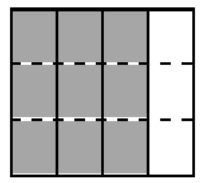
Answer:
3/4 = 9/16.
Explanation:
In the above-given question,
given that,
the shaded fractions have been decomposed into smaller units.
Express the equivalent fractions in a number sentence using multiplication.
3/4 = 3 x 3/4 x 4.
3 x 3 = 9.
4 x 4 = 16.
3/4 = 9/16.
c. 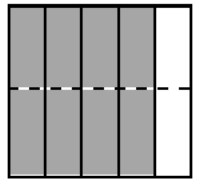
Answer:
4/5 = 8/10.
Explanation:
In the above-given question,
given that,
the shaded fractions have been decomposed into smaller units.
Express the equivalent fractions in a number sentence using multiplication.
4/5 = 4 x 2/5 x 2.
4 x 2 = 8.
5 x 2 = 10.
4/5 = 8/10.
d. 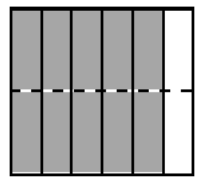
Answer:
5/6 = 10/12.
Explanation:
In the above-given question,
given that,
the shaded fractions have been decomposed into smaller units.
Express the equivalent fractions in a number sentence using multiplication.
5/6 = 5 x 2/6 x 2.
5 x 2 = 10.
6 x 2 = 12.
5/6 = 10/12.
Question 2.
Decompose the shaded fractions into smaller units, as given below. Express the equivalent fractions in a number sentence using multiplication.
a. Decompose into tenths.
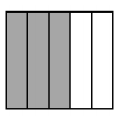
Answer:
3/5 = 6/10.
Explanation:
In the above-given question,
given that,
the shaded fractions have been decomposed into smaller units.
Express the equivalent fractions in a number sentence using multiplication.
3/5 = 3 x 2/5 x 2.
3 x 2 = 6.
5 x 2 = 10.
3/5 = 6/10.
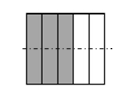
b. Decompose into fifteenths.
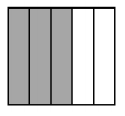
Answer:
3/5 = 9/15.
Explanation:
In the above-given question,
given that,
the shaded fractions have been decomposed into smaller units.
Express the equivalent fractions in a number sentence using multiplication.
3/5 = 3 x 3/5 x 3.
3 x 3 = 9.
5 x 3 = 15.
3/5 = 9/15.

Question 3.
Draw area models to prove that the following number sentences are true.
a. \(\frac{2}{5}\) = \(\frac{4}{10}\)
Answer:
2/5 = 4/10.
Explanation:
In the above-given question,
given that,
the shaded fractions have been decomposed into smaller units.
Express the equivalent fractions in a number sentence using multiplication.
2/5 = 2 x 2/5 x 2.
2 x 2 = 4.
5 x 2 = 10.
2/5 = 4/10.

b. \(\frac{2}{3}\) = \(\frac{8}{12}\)
Answer:
2/3 = 8/12.
Explanation:
In the above-given question,
given that,
the shaded fractions have been decomposed into smaller units.
Express the equivalent fractions in a number sentence using multiplication.
2/3 = 2 x 4/4 x 3.
2 x 4 = 8.
4 x 3 = 12.
2/3 = 8/12.

c. \(\frac{3}{6}\) = \(\frac{6}{12}\)
Answer:
3/6 = 6/12.
Explanation:
In the above-given question,
given that,
the shaded fractions have been decomposed into smaller units.
Express the equivalent fractions in a number sentence using multiplication.
3/6 = 3 x 2/6 x 2.
3 x 2 = 6.
6 x 2 = 12.
3/6 = 6/12.
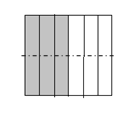
d. \(\frac{4}{6}\) = \(\frac{8}{12}\)
Answer:
4/6 = 8/12.
Explanation:
In the above-given question,
given that,
the shaded fractions have been decomposed into smaller units.
Express the equivalent fractions in a number sentence using multiplication.
4/6 = 4 x 2/6 x 2.
4 x 2 = 8.
6 x 2 = 12.
4/6 = 8/12.
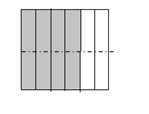
Question 4.
Use multiplication to find an equivalent fraction for each fraction below.
a. \(\frac{3}{4}\)
Answer:
3/4 = 9/16.
Explanation:
In the above-given question,
given that,
the shaded fractions have been decomposed into smaller units.
Express the equivalent fractions in a number sentence using multiplication.
3/4 = 3 x 3/4 x 4.
3 x 3 = 9.
4 x 4 = 16.
3/4 = 9/16.
b. \(\frac{4}{5}\)
Answer:
4/5 = 8/15.
Explanation:
In the above-given question,
given that,
the shaded fractions have been decomposed into smaller units.
Express the equivalent fractions in a number sentence using multiplication.
4/5 = 4 x 2/5 x 3.
4 x 2 = 8.
5 x 3 = 15.
4/5 = 8/15.
c. \(\frac{7}{6}\)
Answer:
7/6 = 14/12.
Explanation:
In the above-given question,
given that,
the shaded fractions have been decomposed into smaller units.
Express the equivalent fractions in a number sentence using multiplication.
7/6 = 7 x 2/6 x 2.
7 x 2 = 14.
6 x 2 = 12.
7/6 = 14/12.
d. \(\frac{12}{7}\)
Answer:
12/7 = 24/14.
Explanation:
In the above-given question,
given that,
the shaded fractions have been decomposed into smaller units.
Express the equivalent fractions in a number sentence using multiplication.
12/7 = 12 x 2/7 x 2.
12 x 2 = 24.
7 x 2 = 14.
12/7 = 24/14.
Question 5.
Determine which of the following are true number sentences. Correct those that are false by changing the right-hand side of the number sentence.
a. \(\frac{4}{3}\) = \(\frac{8}{9}\)
Answer:
4/3 = 8/9.
Explanation:
In the above-given question,
given that,
the shaded fractions have been decomposed into smaller units.
Express the equivalent fractions in a number sentence using multiplication.
4/3 = 4 x 2/3 x 3.
4 x 2 = 8.
3 x 3 = 9.
4/3 = 8/9.
b. \(\frac{5}{4}\) = \(\frac{10}{8}\)
Answer:
5/4 = 10/8.
Explanation:
In the above-given question,
given that,
the shaded fractions have been decomposed into smaller units.
Express the equivalent fractions in a number sentence using multiplication.
5/4 = 5 x 2/4 x 2.
5 x 2 = 10.
4 x 2 = 8.
5/4 = 10/8.
c. \(\frac{4}{5}\) = \(\frac{12}{10}\)
Answer:
4/5 = 12/10 is wrong.
4/5 = 8/10 is correct.
Explanation:
In the above-given question,
given that,
the shaded fractions have been decomposed into smaller units.
Express the equivalent fractions in a number sentence using multiplication.
4/5 = 4 x 2/5 x 2.
4 x 2 = 8.
5 x 2 = 10.
4/5 = 8/10.
d. \(\frac{4}{6}\) = \(\frac{12}{18}\)
Answer:
4/6 = 12/18.
Explanation:
In the above-given question,
given that,
the shaded fractions have been decomposed into smaller units.
Express the equivalent fractions in a number sentence using multiplication.
4/6 = 4 x 3/6 x 3.
4 x 3 = 12.
6 x 3 = 18.
4/6 = 12/18.
Eureka Math Grade 4 Module 5 Lesson 8 Exit Ticket Answer Key
Question 1.
Use multiplication to create an equivalent fraction for the fraction below.
\(\frac{2}{5}\)
Answer:
2/5 = 4/10.
Explanation:
In the above-given question,
given that,
the shaded fractions have been decomposed into smaller units.
Express the equivalent fractions in a number sentence using multiplication.
2/5 = 2 x 2/5 x 2.
2 x 4 = 8.
5 x 2 = 10.
2/5 = 4/10.
Question 2.
Determine if the following is a true number sentence. If needed, correct the statement by changing the right-hand side of the number sentence.
\(\frac{3}{4}\) = \(\frac{9}{8}\)
Answer:
3/4 = 9/8.
Explanation:
In the above-given question,
given that,
the shaded fractions have been decomposed into smaller units.
Express the equivalent fractions in a number sentence using multiplication.
3/4 = 3 x 3/4 x 2.
3 x 3 = 9.
4 x 2 = 8.
3/4 = 9/8.
Eureka Math Grade 4 Module 5 Lesson 8 Homework Answer Key
Each rectangle represents 1.
Question 1.
The shaded fractions have been decomposed into smaller units. Express the equivalent fractions in a number sentence using multiplication. The first one has been done for you.
a. 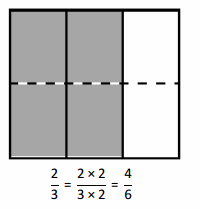
Answer:
2/3 = 4/6.
Explanation:
In the above-given question,
given that,
the shaded fractions have been decomposed into smaller units.
Express the equivalent fractions in a number sentence using multiplication.
2/3 = 2 x 2/3 x 2.
2 x 2 = 4.
3 x 2 = 6.
2/3 = 4/6.
b. 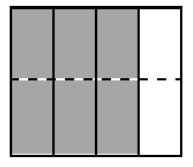
Answer:
3/4 = 6/8.
Explanation:
In the above-given question,
given that,
the shaded fractions have been decomposed into smaller units.
Express the equivalent fractions in a number sentence using multiplication.
3/4 = 3 x 2/4 x 2.
3 x 2 = 6.
4 x 2 = 8.
3/4 = 6/8.
c. 
Answer:
4/5 = 12/15.
Explanation:
In the above-given question,
given that,
the shaded fractions have been decomposed into smaller units.
Express the equivalent fractions in a number sentence using multiplication.
4/5 = 4 x 3/5 x 3.
4 x 3 = 12.
5 x 3 = 15.
4/5 = 12/15.
d. 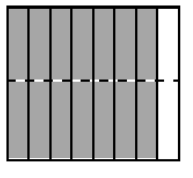
Answer:
7/8 = 14/16.
Explanation:
In the above-given question,
given that,
the shaded fractions have been decomposed into smaller units.
Express the equivalent fractions in a number sentence using multiplication.
7/8 = 7 x 2/8 x 2.
7 x 2 = 14.
8 x 2 = 16.
7/8 = 14/16.
Question 2.
Decompose both shaded fractions into twelfths. Express the equivalent fractions in a number sentence using multiplication.
a. 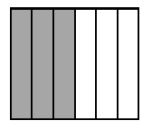
Answer:
3/6 = 9/12.
Explanation:
In the above-given question,
given that,
the shaded fractions have been decomposed into smaller units.
Express the equivalent fractions in a number sentence using multiplication.
3/6 = 3 x 3/6 x 2.
3 x 3 = 9.
6 x 2 = 12.
3/6 = 9/12.

b. 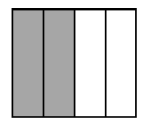
Answer:
2/4 = 6/12.
Explanation:
In the above-given question,
given that,
the shaded fractions have been decomposed into smaller units.
Express the equivalent fractions in a number sentence using multiplication.
2/4 = 2 x 3/4 x 3.
3 x 2 = 6.
4 x 3 = 12.
2/4 = 6/12.
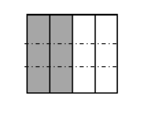
Question 3.
Draw area models to prove that the following number sentences are true.
a. \(\frac{1}{3}\) = \(\frac{2}{6}\)
Answer:
1/3 = 2/6.
Explanation:
In the above-given question,
given that,
the shaded fractions have been decomposed into smaller units.
Express the equivalent fractions in a number sentence using multiplication.
1/3 = 1 x 2/3 x 2.
1 x 2 = 2.
3 x 2 = 6.
1/3 = 2/6.
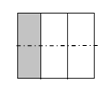
b. \(\frac{2}{5}\) = \(\frac{4}{10}\)
Answer:
2/5 = 4/10.
Explanation:
In the above-given question,
given that,
the shaded fractions have been decomposed into smaller units.
Express the equivalent fractions in a number sentence using multiplication.
2/5 = 2 x 2/5 x 2.
2 x 2 = 4.
5 x 2 = 10.
2/5 = 4/10.

c. \(\frac{5}{7}\) = \(\frac{10}{14}\)
Answer:
5/7 = 10/14.
Explanation:
In the above-given question,
given that,
the shaded fractions have been decomposed into smaller units.
Express the equivalent fractions in a number sentence using multiplication.
5/7 = 5 x 2/7 x 2.
5 x 2 = 10.
7 x 2 = 14.
5/7 = 10/14.

d. \(\frac{3}{6}\) = \(\frac{9}{18}\)
Answer:
3/6 = 9/18.
Explanation:
In the above-given question,
given that,
the shaded fractions have been decomposed into smaller units.
Express the equivalent fractions in a number sentence using multiplication.
3/6 = 3 x 3/6 x 3.
3 x 3 = 9.
6 x 3 = 18.
3/6 = 9/18.

Question 4.
Use multiplication to create an equivalent fraction for each fraction below.
a. \(\frac{2}{3}\)
Answer:
2/3 = 4/6.
Explanation:
In the above-given question,
given that,
the shaded fractions have been decomposed into smaller units.
Express the equivalent fractions in a number sentence using multiplication.
2/3 = 2 x 2/3 x 2.
2 x 2 = 4.
3 x 2 = 6.
2/3 = 4/6.
b. \(\frac{5}{6}\)
Answer:
5/6 = 10/12.
Explanation:
In the above-given question,
given that,
the shaded fractions have been decomposed into smaller units.
Express the equivalent fractions in a number sentence using multiplication.
5/6 = 5 x 2/6 x 2.
5 x 2 = 10.
6 x 2 = 12.
5/6 = 10/12.
c. \(\frac{6}{5}\)
Answer:
6/5 = 12/10.
Explanation:
In the above-given question,
given that,
the shaded fractions have been decomposed into smaller units.
Express the equivalent fractions in a number sentence using multiplication.
6/5 = 6 x 2/5 x 2.
6 x 2 = 12.
5 x 2 = 10.
6/5 = 12/10.
d. \(\frac{10}{8}\)
Answer:
10/8 = 5/4.
Explanation:
In the above-given question,
given that,
the shaded fractions have been decomposed into smaller units.
Express the equivalent fractions in a number sentence using multiplication.
10/8 = 5 x 2/2 x 2.
5 x 2 = 10.
2 x 2 = 4.
10/8 = 5/4.
Question 5.
Determine which of the following are true number sentences. Correct those that are false by changing the right-hand side of the number sentence.
a. \(\frac{2}{3}\) = \(\frac{4}{9}\)
Answer:
2/3 = 4/9.
Explanation:
In the above-given question,
given that,
the shaded fractions have been decomposed into smaller units.
Express the equivalent fractions in a number sentence using multiplication.
2/3 = 2 x 2/3 x 3.
2 x 2 = 4.
3 x 3 = 9.
2/3 = 4/9.
b. \(\frac{5}{6}\) = \(\frac{10}{12}\)
Answer:
5/6 = 10/12.
Explanation:
In the above-given question,
given that,
the shaded fractions have been decomposed into smaller units.
Express the equivalent fractions in a number sentence using multiplication.
5/6 = 5 x 2/6 x 2.
5 x 2 = 10.
6 x 2 = 12.
5/6 = 10/12.
c. \(\frac{3}{5}\) = \(\frac{6}{15}\)
Answer:
3/5 = 6/15 is wrong.
3/5 = 9/15 is correct.
Explanation:
In the above-given question,
given that,
the shaded fractions have been decomposed into smaller units.
Express the equivalent fractions in a number sentence using multiplication.
3/5 = 3 x 3/ 5 x 3.
3 x 3 = 9.
5 x 3 = 15.
3/5 = 9/15.
d. \(\frac{7}{4}\) = \(\frac{21}{12}\).
Answer:
7/4 = 21/12.
Explanation:
In the above-given question,
given that,
the shaded fractions have been decomposed into smaller units.
Express the equivalent fractions in a number sentence using multiplication.
7/4 = 7 x 3/4 x 3.
7 x 3 = 21.
4 x 3 = 12.
7/4 = 21/12.